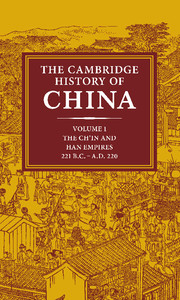Crossref Citations
This Book has been
cited by the following publications. This list is generated based on data provided by Crossref.
Rudolph, Susanne Hoeber
1987.
Presidential Address: State Formation in Asia—Prolegomenon to a Comparative Study.
The Journal of Asian Studies,
Vol. 46,
Issue. 4,
p.
731.
Bishop, M. C.
1989.
The articulated cuirass in Qin dynasty China.
Antiquity,
Vol. 63,
Issue. 241,
p.
697.
Nylan, Michael
1993.
Style, Patronage, and Confucian Ideals in Han Dynasty Art: Problems in Interpretation.
Early China,
Vol. 18,
Issue. ,
p.
227.
Campany, Robert F.
1994.
Religious Methods and Resources in Bioethics.
Vol. 2,
Issue. ,
p.
67.
Wang, Eugene Yuejin
1994.
Mirror, Death, and Rhetoric: Reading Later Han Chinese Bronze Artifacts.
The Art Bulletin,
Vol. 76,
Issue. 3,
p.
511.
Taylor, Rodney
and
Arbuckle, Gary
1995.
Confucianism.
The Journal of Asian Studies,
Vol. 54,
Issue. 2,
p.
347.
Xiong, Victor Cunrui
1995.
The Four Groups(Simin) and Farmer-Merchant Antithesis in Early Imperial China.
Chinese Historians,
Vol. 8,
Issue. 1-2,
p.
85.
Wingrove, Paul
1995.
Mao in Moscow, 1949–50: Some new archival evidence.
Journal of Communist Studies and Transition Politics,
Vol. 11,
Issue. 4,
p.
309.
Hall, David L.
and
Ames, Roger T.
1998.
The cosmological setting of Chinese gardens.
Studies in the History of Gardens & Designed Landscapes,
Vol. 18,
Issue. 3,
p.
175.
Loewe, Michael
and
Shaughnessy, Edward L.
1999.
The Cambridge History of Ancient China.
p.
1.
Dykeman, Therese Boos
1999.
The Neglected Canon: Nine Women Philosophers.
p.
5.
Loewe, Michael
and
Shaughnessy, Edward L.
1999.
The Cambridge History of Ancient China.
Sellmann, James D.
1999.
The origin and role of the state according to theLüshi chunqiu.
Asian Philosophy,
Vol. 9,
Issue. 3,
p.
193.
Killigrew, John W.
2001.
A case study of Chinese civil warfare: The Cao‐Wei conquest of Shu‐Han in AD 263.
Civil Wars,
Vol. 4,
Issue. 4,
p.
95.
Liu, Li
2005.
The Chinese Neolithic.
Sellmann, James D.
2006.
On the Origin of Shang and Zhou Law.
Asian Philosophy,
Vol. 16,
Issue. 1,
p.
49.
Cen, Guozhen
2008.
Chinese adolescents' attitudes towards collective and communicable responsibility.
Journal of Moral Education,
Vol. 37,
Issue. 2,
p.
185.
Dauben, Joseph W.
2008.
Suan Shu Shu A Book on Numbers and Computations.
Archive for History of Exact Sciences,
Vol. 62,
Issue. 2,
p.
91.
Raphals 瑞麗, Lisa
2009.
Divination in theHan shuBibliographic Treatise.
Early China,
Vol. 32,
Issue. ,
p.
45.
Feinman, Gary M.
Nicholas, Linda M.
and
Hui, Fang
2010.
The imprint of China’s first emperor on the distant realm of eastern Shandong.
Proceedings of the National Academy of Sciences,
Vol. 107,
Issue. 11,
p.
4851.



